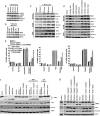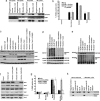Nicotine inhibits apoptosis induced by chemotherapeutic drugs by up-regulating XIAP and survivin
- PMID: 16601104
- PMCID: PMC1458878
- DOI: 10.1073/pnas.0509313103
Nicotine inhibits apoptosis induced by chemotherapeutic drugs by up-regulating XIAP and survivin
Abstract
Non-small cell lung cancer (NSCLC) demonstrates a strong etiologic association with smoking. Although nicotine is not carcinogenic, it can induce cell proliferation and angiogenesis and suppress apoptosis induced by certain agents. Here we show that nicotine inhibits apoptosis induced by the drugs gemcitabine, cisplatin, and taxol, which are used to treat NSCLCs. This protection correlated with the induction of XIAP and survivin by nicotine in a panel of human NSCLC cell lines, and depletion of XIAP and survivin ablated the protective effects of nicotine. The antiapoptotic effects of nicotine were mediated by dihydro beta-erythroidine-sensitive alpha3-containing nicotinic acetylcholine receptors and required the Akt pathway. Chromatin immunoprecipitation assays demonstrated that nicotine stimulation caused an increased recruitment of E2F1 and concomitant dissociation of retinoblastoma tumor suppressor protein (Rb) from survivin promoter in A549 cells. Moreover, ablation of E2F1 levels caused abrogation of the protective effects of nicotine against cisplatin-induced apoptosis in A549 cells whereas ablation of signal transducer and activator of transcription 3 levels had no effect. These studies suggest that exposure to nicotine might negatively impact the apoptotic potential of chemotherapeutic drugs and that survivin and XIAP play a key role in the antiapoptotic activity of nicotine.
Conflict of interest statement
Conflict of interest statement: No conflicts declared.
Figures



Similar articles
-
Nicotine inhibits apoptosis induced by cisplatin in human oral cancer cells.Int J Oral Maxillofac Surg. 2007 Aug;36(8):739-44. doi: 10.1016/j.ijom.2007.05.016. Epub 2007 Jul 3. Int J Oral Maxillofac Surg. 2007. PMID: 17611077
-
Degradation of survivin by the X-linked inhibitor of apoptosis (XIAP)-XAF1 complex.J Biol Chem. 2007 Sep 7;282(36):26202-9. doi: 10.1074/jbc.M700776200. Epub 2007 Jul 5. J Biol Chem. 2007. PMID: 17613533
-
Silencing of X-linked inhibitor of apoptosis decreases resistance to cisplatin and paclitaxel but not gemcitabine in non-small cell lung cancer.J Int Med Res. 2011;39(5):1682-92. doi: 10.1177/147323001103900510. J Int Med Res. 2011. PMID: 22117968
-
Nicotine-induced resistance of non-small cell lung cancer to treatment--possible mechanisms.Postepy Hig Med Dosw (Online). 2016 Mar 4;70:186-93. doi: 10.5604/17322693.1196391. Postepy Hig Med Dosw (Online). 2016. PMID: 26943316 Review.
-
Oncogenes as novel targets for cancer therapy (part IV): regulators of the cell cycle and apoptosis.Am J Pharmacogenomics. 2005;5(6):397-407. doi: 10.2165/00129785-200505060-00006. Am J Pharmacogenomics. 2005. PMID: 16336004 Review.
Cited by
-
Cellular Concentration of Survivin and Caspase 3 in Habitual Tobacco Chewers with and without Oral Squamous Cell Carcinoma in South Indian Rural Population-A Case Control Study.Diagnostics (Basel). 2022 Sep 18;12(9):2249. doi: 10.3390/diagnostics12092249. Diagnostics (Basel). 2022. PMID: 36140650 Free PMC article.
-
Exposure to nicotine-derived nitrosamine ketone and arecoline synergistically facilitates tumor aggressiveness via overexpression of epidermal growth factor receptor and its downstream signaling in head and neck squamous cell carcinoma.PLoS One. 2018 Aug 27;13(8):e0201267. doi: 10.1371/journal.pone.0201267. eCollection 2018. PLoS One. 2018. PMID: 30148841 Free PMC article.
-
Small molecule regulators of Rb-E2F pathway as modulators of transcription.Biochim Biophys Acta. 2010 Oct-Dec;1799(10-12):788-94. doi: 10.1016/j.bbagrm.2010.07.004. Epub 2010 Jul 15. Biochim Biophys Acta. 2010. PMID: 20637913 Free PMC article. Review.
-
ARRB1-mediated regulation of E2F target genes in nicotine-induced growth of lung tumors.J Natl Cancer Inst. 2011 Feb 16;103(4):317-33. doi: 10.1093/jnci/djq541. Epub 2011 Jan 6. J Natl Cancer Inst. 2011. PMID: 21212384 Free PMC article.
-
Role of alpha7-nicotinic acetylcholine receptor in human non-small cell lung cancer proliferation.Cell Prolif. 2008 Dec;41(6):936-59. doi: 10.1111/j.1365-2184.2008.00566.x. Cell Prolif. 2008. Retraction in: Cell Prolif. 2017 Dec;50(6):e12379. doi: 10.1111/cpr.12379. PMID: 19040571 Free PMC article. Retracted.
References
-
- Johnson D. H., Schiller J. H. Cancer Chemother. Biol. Response Modif. 2002;20:763–786. - PubMed
-
- Sekido Y., Fong K. M., Minna J. D. Annu. Rev. Med. 2003;54:73–87. - PubMed
-
- Minna J. D., Fong K., Zochbauer-Muller S., Gazdar A. F. Cancer J. 2002;8(Suppl. 1):S41–S46. - PubMed
-
- Wu X. H., Wang H. F., Liu Y. F., Lu X. Y., Wang J. J., Li K. Radiocarbon. 1997;39:293–297.
-
- Li X. S., Wang H. F., Wang X. Y., Liu Y. F., Li K., Lu X. Y., Wang J. J., Liu K. X., Guo Z. Y. Radiocarbon. 1996;38:347–353.
Publication types
MeSH terms
Substances
Grants and funding
LinkOut - more resources
Full Text Sources
Other Literature Sources
Medical
Molecular Biology Databases

